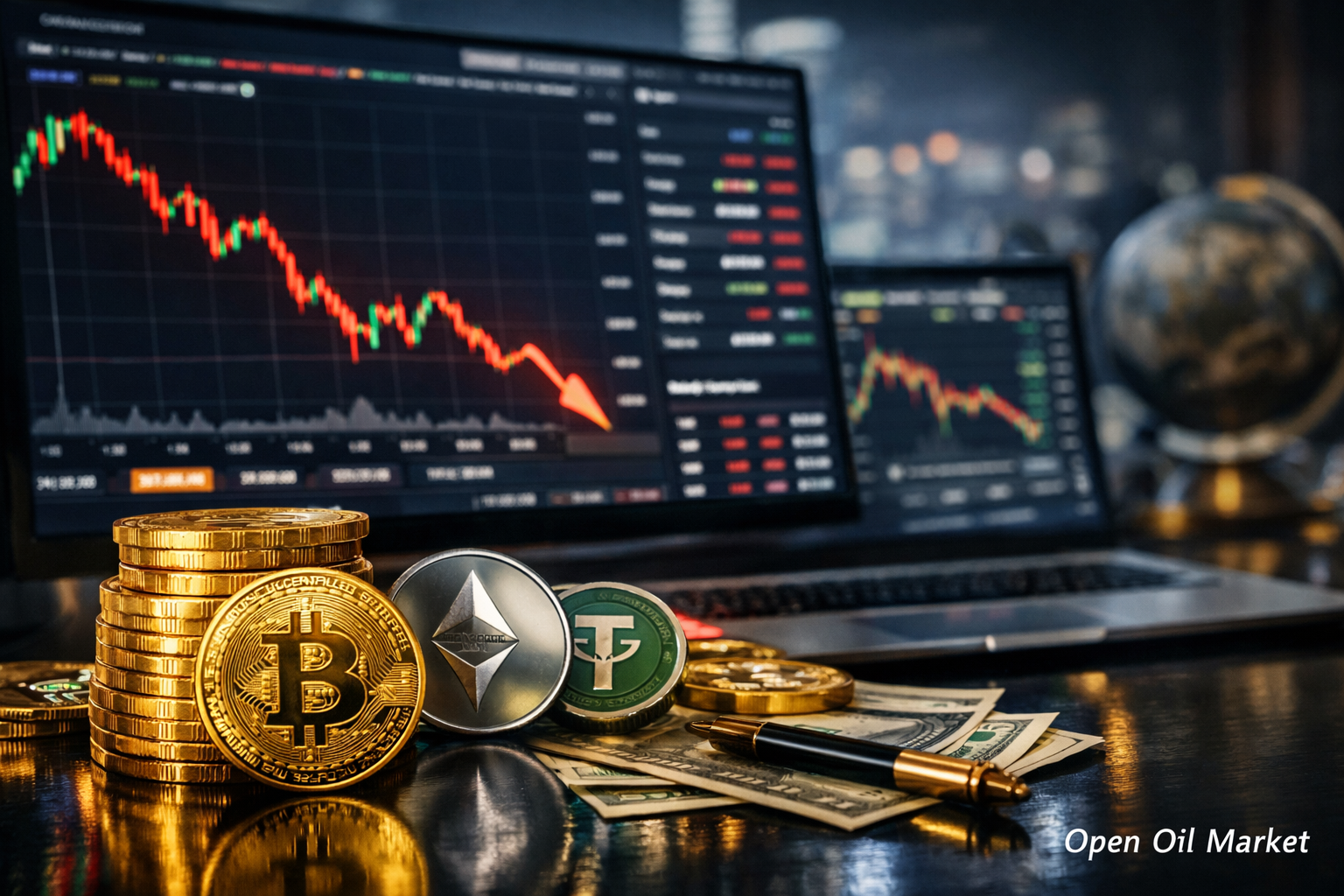
Current Cryptocurrency News as of October 30, 2025: Bitcoin Hits Record High, Altcoins Strengthen, Institutional Investments, ETF Launches, and Market Trends. Investor Forecasts.
The cryptocurrency market continues to show solid growth amid improving global sentiment. Bitcoin has stabilized near historic highs, approaching the mark of $113,000 per coin, while many altcoins enjoy strong rallies. Investors are optimistically receiving fresh news: the anticipated easing of U.S. monetary policy and signs of reduced trade tensions between the U.S. and China are supporting demand for digital assets. The total market capitalization of cryptocurrencies has surpassed $3 trillion, with Bitcoin’s market share exceeding 50%, reflecting its dominant position. Overall, sentiments are close to a business optimism, though volatility persists and experts warn of risks.
Bitcoin Near Historical Peak
Bitcoin (BTC) is trading at record high levels, holding in a range of $110,000–115,000, just around 10% off its all-time peak. Over the past week, the largest cryptocurrency has consolidated in a range near $112,000, establishing a new base following its recent surge. Analysts note that support at the $112,000 level is strong – maintaining this mark opens up potential for the next leap to $116,000–120,000 in the near term. Bitcoin's growth in 2025 is impressive with double-digit percentages, reflecting a return of investor interest in risk assets as monetary policy eases. Bitcoin has also gained support from institutional buyers – capital inflows into BTC-related investment products are hitting records. However, some observers point out that, despite the growth, Bitcoin has not yet outperformed traditional markets: the NASDAQ technology index has reached a historical maximum, emphasizing a certain relative "caution" in the crypto market. Nevertheless, the correlation of BTC with stock indices remains positive, and further rises in stocks could push the cryptocurrency upwards.
Expectations of Easing from the Fed
The key factor influencing the digital currency market has been the upcoming decision by the U.S. Federal Reserve. At its meeting on Wednesday evening, the Fed is expected to lower the benchmark interest rate by 0.25 percentage points to a range of 3.75–4.00% annually. This marks the first rate cut in a while, reflecting slowing inflation and signals of a cooling economy. Market participants had anticipated this easing in their pricing: the expectations of cheaper money and the possible end of quantitative tightening (QT) create a favorable backdrop for the growth of cryptocurrencies. A lower rate traditionally weakens the dollar and supports demand for risk assets, including Bitcoin and Ethereum. Many investors are counting on the dovish tone of Fed Chair Jerome Powell leading to further liquidity influxes into the markets. However, experts warn of the classic “sell the news” effect – after the actual announcement of the rate cut, there may be short-term profit-taking and price fluctuations. An important signal will be the Fed's rhetoric regarding future steps: if the regulator indicates that a pause or caution in further easing is warranted, the cryptocurrency market may take a breather for consolidation. Overall, the Fed's decision has acted as a positive driver, strengthening investor confidence in digital assets.
U.S.-China Deal and Global Background
Apart from monetary factors, participants in the crypto market are closely monitoring geopolitical news. It has been revealed that U.S. President Donald Trump and Chinese President Xi Jinping plan to meet in the coming days to finalize a trade agreement. The prospect of easing trade tensions between the two largest economies in the world is inspiring global markets. The U.S.-China agreement is expected to reduce tariff barriers and bolster business confidence, already leading to a rise in stock indices in the U.S. and China. Indirectly, this positively affects cryptocurrencies; analysts note that Bitcoin has shown an increasingly strong correlation with the stock market in recent years. Improved relations between the two economic superpowers could enhance investors’ risk appetite worldwide. In Asia, traditionally active in crypto trading, the positive news backdrop supports capital inflow into digital assets. Thus, progress in the dialogue between Washington and Beijing has become yet another macroeconomic factor supporting the cryptocurrency rally this week.
Altcoin Dynamics: Selective Rally
The altcoin market shows mixed dynamics: a number of digital currencies are rising confidently alongside Bitcoin, yet the growth is selective. Many major altcoins are consolidating around important levels, while riskier tokens are exhibiting spikes in volatility. The overall altcoin "season" index, according to CoinMarketCap, stands at 26 out of 100, indicating Bitcoin’s prevailing leadership in the current growth round. Nevertheless, investors are keeping a close eye on movements in the altcoin segment, where localized rallies are emerging.
- Ethereum (ETH) is holding around the psychological mark of $4,000, occasionally facing selling pressure. Despite a recent correction to approximately $3,900, Ethereum quickly recovered to $4,000. So far, the second-largest cryptocurrency by market cap isn't displaying rapid growth; however, its resilience indicates ongoing investor interest. Potential further easing of Fed policy and capital inflow into ETH-ETF are creating conditions for a new phase of Ethereum growth.
- A number of speculative tokens from the "meme coins" and DeFi sectors surged sharply in the past day. For instance, the token TRUMP, associated with the previous U.S. president, rose double digits after news of its listing on an exchange and expectations surrounding the U.S.-China trade deal. Similar dynamics are seen with other niche altcoins – for example, AERO gained about 7%, reaching a month-high amid activity in its DeFi sector. Such spikes reflect heightened risk appetite among certain traders but are localized in nature.
- Major altcoins from the top 10 by market cap are generally moving more cautiously. For example, Ripple (XRP) is trading around $2.60, consolidating after recent weeks' rally. XRP is at multi-year highs due to Ripple's court victory against the SEC and expectations for the launch of the first ETFs on this token. Solana (SOL) approached the $200 mark amid the recent launch of its own ETF in the U.S., although it remains below its peak in 2021. Conversely, Hedera (HBAR) has pulled back about 4–5% after the launch of a spot-ETF on HBAR, with investors taking profits on the news. Overall, cryptocurrency "blue chips" (ETH, XRP, BNB, SOL, etc.) are currently mainly consolidating, and capital inflows into them may resume as macro conditions clarify.
Volatility and Risks in the Market
Despite the overall upward trend, the crypto market maintains high volatility, and experts urge investors to exercise caution. At the beginning of the week, a sharp price drop ("flash crash") occurred: the total market capitalization briefly plummeted by about 1.5%, and positions worth over $20 billion were liquidated on futures exchanges. The rapid price recovery following this episode demonstrated consistent demand for leading cryptocurrencies; however, such spikes indicate the fragility of market balance amid unexpected liquidity outflows. Noted economist and long-time Bitcoin critic Peter Schiff once again warned of the potential for a "bubble" in the crypto market. He noted that against the backdrop of the NASDAQ reaching historical highs and gold prices rising, Bitcoin continues to trade below its record, and some crypto-related stocks (e.g., MicroStrategy) are far from peak values. Skeptics suggest that Bitcoin's lag behind traditional assets may signal weak demand and an impending correction. An additional risk factor is limited liquidity: although the Fed is cutting rates, it has yet to resort to stimulating measures such as quantitative easing (QE), hence the dollar shortage in the financial system continues to curtail capital inflows. In such conditions, professional traders advise avoiding excessive leverage and being prepared for price fluctuations. However, many market participants view any price rollbacks as an opportunity to accumulate positions – as analysts note, major players are buying Bitcoin during dips, considering the level around ~$112,000 an attractive entry point.
Institutional Investments and Crypto ETFs
One of the main trends of fall 2025 has been the rapid expansion of available investment products linked to cryptocurrencies on traditional exchanges. Following the launch of spot ETFs for Bitcoin and Ethereum, U.S. markets began trading the first ETFs on several altcoins. Over the past few days, spot funds tracking the prices of Solana (SOL), Litecoin (LTC), and Hedera (HBAR) have begun trading on the New York Stock Exchange. The launch of these products marks a new era of institutional recognition: investors can now gain access to leading altcoins through familiar exchange instruments. Initially, market reactions were mixed; for instance, the price of HBAR dropped after the ETF launch, reflecting the principle of “sell on the news.” Nevertheless, in the mid-term, the emergence of altcoin ETFs broadens capital inflow opportunities in the crypto sector.
Capital inflows into crypto funds have significantly increased: on just one day, October 28, net investments in spot Bitcoin and Ethereum ETFs exceeded $440 million. Ethereum stood out particularly; new Ethereum ETFs accounted for more than half of this amount, signaling growing institutional interest in the second-largest cryptocurrency. Analysts note that sustained capital inflows through ETFs indicate increased trust from large investors and funds. Furthermore, the market eagerly awaits regulatory decisions on applications for launching the first spot ETFs on XRP (Ripple). The U.S. Securities and Exchange Commission is reviewing several applications, with experts estimating the chances of approval in the coming months as very high – up to 99%. The recent resolution of the legal dispute between Ripple and the SEC has removed legal uncertainty surrounding XRP, paving the way for such products. The anticipated launch of the XRP ETF could attract a new stream of institutional money and further stimulate growth in the altcoin market.
Regulation and Implementation: Global News
The regulatory agenda surrounding cryptocurrencies remains mixed in different parts of the world. On one hand, some countries are seeking ways to integrate digital assets into the financial system. In France, an ambitious bill for the creation of a national Bitcoin reserve was presented this week. According to the initiative put forth by deputy Éric Ciotti, the government plans to acquire approximately 420,000 BTC (about 2% of the total Bitcoin supply) over 7-8 years, gradually forming a strategic reserve. The proposed financing for the purchases would come from state funds (around €15 million per day), and part of the coins would be mined on French territory using nuclear and hydroelectric energy. Moreover, the project suggests retaining confiscated cryptocurrency in the treasury (instead of selling it at auctions) and allows for the possibility of paying taxes in Bitcoin. Although this initiative is still in the proposal stage, it indicates a growing interest from authorities in certain countries in cryptocurrencies as strategic assets.
On the other hand, several countries continue to impose strict measures against unauthorized use of cryptocurrencies. In China, a court sentenced a group of five individuals to prison terms ranging from 2 to 4 years for illegal currency operations involving crypto assets. The perpetrators converted large sums of yuan into Tether (USDT) and transferred them abroad, circumventing strict currency controls. The volume of illegal operations exceeded $166 million. This precedent highlights the continued policy of Beijing to maintain strict control over the crypto industry and to curb attempts to bypass financial rules using digital currencies. Thus, there is a global divergence in approaches: while some countries (U.S., European nations) are enacting regulations that effectively integrate cryptocurrencies into the economy, others (China and several developing markets) are intensifying bans and penalties. Investors need to consider regulatory risks in different jurisdictions when planning their strategy with crypto assets.
Top 10 Most Popular Cryptocurrencies
- Bitcoin (BTC) – approximately $113,000. The dominant cryptocurrency number 1, with a market capitalization exceeding $2 trillion. Bitcoin has stabilized close to its historical maximum, reinforcing its market leadership. Institutional interest and limited supply continue to drive BTC upwards.
- Ethereum (ETH) – approximately $4,000. The second-largest cryptocurrency by market cap, a platform for smart contracts. Ethereum shows stability and awaits new growth drivers, including the launch of institutional products (ETFs) and network updates.
- Tether (USDT) – $1.00 (stablecoin). The largest stablecoin pegged to the dollar. USDT provides liquidity in the market, remaining the primary means of settlement between cryptocurrencies. Its market capitalization is around $85 billion, reflecting high demand for dollar liquidity in the crypto ecosystem.
- BNB (BNB) – approximately $1,100. The token of the largest cryptocurrency exchange, Binance, and its blockchain ecosystem. BNB has reached new heights due to increased activity on Binance Smart Chain and an expansion of exchange services. The coin has entered the top three by market capitalization.
- XRP (Ripple) – approximately $2.60. The token associated with the Ripple payment platform. XRP has seen a sharp price increase following Ripple's legal victory over the SEC and expectations for ETF approval. Currently, XRP is at multi-year highs and has secured its place among the top five largest cryptocurrencies.
- USD Coin (USDC) – $1.00 (stablecoin). The second-largest dollar stablecoin, issued by the Centre consortium (Circle and Coinbase). USDC is used by institutional investors for entering crypto assets, with its market capitalization around $50 billion. The coin maintains trust through regular audit reports.
- Solana (SOL) – approximately $195. A promising layer one blockchain known for its high transaction speed. SOL has seen a significant price increase in 2025, especially after the launch of the first ETF on Solana. Although the price has yet to reach its historical peak from 2021 (~$260), Solana remains one of the fastest-growing projects.
- Dogecoin (DOGE) – approximately $0.19. The most well-known meme cryptocurrency, initially created as a joke. DOGE has returned to the top 10 thanks to community support and periodic attention from well-known entrepreneurs. In the current market uptrend, Dogecoin is gradually regaining its position, although it is far from its record $0.73 reached in 2021.
- Tron (TRX) – approximately $0.30. A blockchain platform for smart contracts and decentralized applications, popular in Asia. TRX is showing steady growth, with its current price close to multi-year highs. Tron is actively used for issuing stablecoins and provides high throughput, which attracts DeFi users.
- Cardano (ADA) – approximately $0.64. A cryptocurrency and blockchain platform that is developing with a focus on a scientific approach (peer-review). ADA consistently holds in the leader's top ten, although its price remains significantly below historical records ($3+). In 2025, the Cardano project continued technical updates, strengthening its ecosystem ahead of a new potential growth wave.




